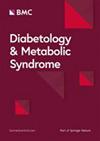Independent effects of the glucose-to-glycated hemoglobin ratio on mortality in critically ill patients with atrial fibrillation
IF 3.9
3区 医学
Q2 ENDOCRINOLOGY & METABOLISM
引用次数: 0
Abstract
The glucose-to-glycated hemoglobin ratio (GAR) represents stress hyperglycemia, which has been closely associated with adverse outcomes in cardio-cerebrovascular diseases. No studies have examined the association between stress hyperglycemia and atrial fibrillation (AF) in critically ill patients. This study aims to explore the relationship between GAR and the prognosis of critically ill patients with AF. A retrospective cohort of patients was selected from the Medical Information Mart for Intensive Care IV (MIMIC-IV) database. The GAR was calculated based on fasting blood glucose and glycated hemoglobin levels measured after admission. The primary outcome was the 30-day mortality rate, with secondary outcomes being the 90-day and 365-day mortality rates. The GAR was divided into tertiles, and Kaplan–Meier analysis was employed to compare differences in mortality rates between groups. The Cox proportional hazards model and restricted cubic splines (RCS) were utilized to evaluate the relationship between the GAR and mortality. Subsequently, a segmented regression model was constructed to analyze threshold effects in cases where nonlinear relationships were determined. In this cohort, the second tertile of the GAR exhibited lower mortality rates at 30 days (10.56% vs 6.33% vs 14.51%), 90 days (17.11% vs 10.09% vs 17.88%), and 365 days (25.30% vs 16.15% vs 22.72%). In the third tertile, the risk of mortality at 30 days increased by 165% (HR = 2.65, 95% CI 1.99–3.54, p < 0.001), at 90 days increased by 113% (HR = 2.13, 95% CI 1.68–2.70, p < 0.001), and at 365 days increased by 70% (HR = 1.70, 95% CI 1.68–2.70, p < 0.001). The association between the GAR and patient mortality demonstrated a “J-shaped” non-linear correlation. Once the GAR exceeded 15.915, each incremental unit increase in the ratio was associated with a 27.2% increase in the risk of 30-day mortality in critically ill atrial fibrillation patients (HR = 1.262, 95% CI 1.214–1.333, p < 0.001). The GAR is associated with both short-term and long-term mortality in critically ill patients with AF in a J-shaped relationship. Both low and excessively high GAR values indicate poor prognosis.葡萄糖与糖化血红蛋白比率对心房颤动重症患者死亡率的独立影响
血糖与糖化血红蛋白比值(GAR)代表应激性高血糖,它与心脑血管疾病的不良预后密切相关。目前还没有研究探讨过危重症患者应激性高血糖与心房颤动(房颤)之间的关系。本研究旨在探讨 GAR 与心房颤动危重症患者预后之间的关系。研究人员从重症监护医学信息市场第四版(MIMIC-IV)数据库中选取了一批回顾性患者。GAR 根据入院后测量的空腹血糖和糖化血红蛋白水平计算得出。主要结果是 30 天死亡率,次要结果是 90 天和 365 天死亡率。GAR 被分为三等分,并采用 Kaplan-Meier 分析来比较组间死亡率的差异。采用 Cox 比例危险模型和限制性立方样条(RCS)来评估 GAR 与死亡率之间的关系。随后,在确定非线性关系的情况下,构建了分段回归模型来分析阈值效应。在该队列中,GAR 的第二个三分位数在 30 天(10.56% vs 6.33% vs 14.51%)、90 天(17.11% vs 10.09% vs 17.88%)和 365 天(25.30% vs 16.15% vs 22.72%)的死亡率较低。在第三个三分位数中,30 天的死亡风险增加了 165%(HR = 2.65,95% CI 1.99-3.54,p < 0.001),90 天的死亡风险增加了 113%(HR = 2.13,95% CI 1.68-2.70,p < 0.001),365 天的死亡风险增加了 70%(HR = 1.70,95% CI 1.68-2.70,p < 0.001)。GAR 与患者死亡率之间呈现出 "J "型非线性相关性。一旦 GAR 超过 15.915,该比率每增加一个增量单位,重症心房颤动患者的 30 天死亡风险就会增加 27.2%(HR = 1.262,95% CI 1.214-1.333,p < 0.001)。GAR与心房颤动重症患者的短期和长期死亡率呈 "J "形关系。GAR值过低和过高都预示着预后不良。
本文章由计算机程序翻译,如有差异,请以英文原文为准。
求助全文
约1分钟内获得全文
求助全文
来源期刊

Diabetology & Metabolic Syndrome
ENDOCRINOLOGY & METABOLISM-
CiteScore
6.20
自引率
0.00%
发文量
170
审稿时长
7.5 months
期刊介绍:
Diabetology & Metabolic Syndrome publishes articles on all aspects of the pathophysiology of diabetes and metabolic syndrome.
By publishing original material exploring any area of laboratory, animal or clinical research into diabetes and metabolic syndrome, the journal offers a high-visibility forum for new insights and discussions into the issues of importance to the relevant community.
 求助内容:
求助内容: 应助结果提醒方式:
应助结果提醒方式:


